Mechanism of primitive duct formation in the pancreas and submandibular glands: a role for SDF-1
- PMID: 20003423
- PMCID: PMC2801489
- DOI: 10.1186/1471-213X-9-66
Mechanism of primitive duct formation in the pancreas and submandibular glands: a role for SDF-1
Abstract
Background: The exocrine pancreas is composed of a branched network of ducts connected to acini. They are lined by a monolayered epithelium that derives from the endoderm and is surrounded by mesoderm-derived mesenchyme. The morphogenic mechanisms by which the ductal network is established as well as the signaling pathways involved in this process are poorly understood.
Results: By morphological analyzis of wild-type and mutant mouse embryos and using cultured embryonic explants we investigated how epithelial morphogenesis takes place and is regulated by chemokine signaling. Pancreas ontogenesis displayed a sequence of two opposite epithelial transitions. During the first transition, the monolayered and polarized endodermal cells give rise to tissue buds composed of a mass of non polarized epithelial cells. During the second transition the buds reorganize into branched and polarized epithelial monolayers that further differentiate into tubulo-acinar glands. We found that the second epithelial transition is controlled by the chemokine Stromal cell-Derived Factor (SDF)-1. The latter is expressed by the mesenchyme, whereas its receptor CXCR4 is expressed by the epithelium. Reorganization of cultured pancreatic buds into monolayered epithelia was blocked in the presence of AMD3100, a SDF-1 antagonist. Analyzis of sdf1 and cxcr4 knockout embryos at the stage of the second epithelial transition revealed transient defective morphogenesis of the ventral and dorsal pancreas. Reorganization of a globular mass of epithelial cells in polarized monolayers is also observed during submandibular glands development. We found that SDF-1 and CXCR4 are expressed in this organ and that AMD3100 treatment of submandibular gland explants blocks its branching morphogenesis.
Conclusion: In conclusion, our data show that the primitive pancreatic ductal network, which is lined by a monolayered and polarized epithelium, forms by remodeling of a globular mass of non polarized epithelial cells. Our data also suggest that SDF-1 controls the branching morphogenesis of several exocrine tissues.
Figures
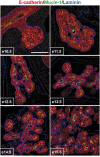
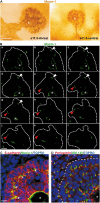
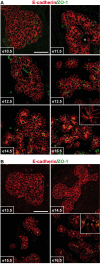

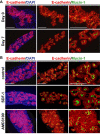

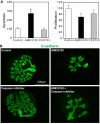
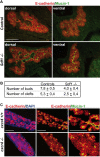

Similar articles
-
The role of CXCL12-CXCR4 signaling pathway in pancreatic development.Theranostics. 2013;3(1):11-7. doi: 10.7150/thno.4806. Epub 2013 Jan 12. Theranostics. 2013. PMID: 23382781 Free PMC article. Review.
-
CXCR4 Regulates Temporal Differentiation via PRC1 Complex in Organogenesis of Epithelial Glands.Int J Mol Sci. 2021 Jan 10;22(2):619. doi: 10.3390/ijms22020619. Int J Mol Sci. 2021. PMID: 33435128 Free PMC article.
-
AMD3100 inhibits epithelial-mesenchymal transition, cell invasion, and metastasis in the liver and the lung through blocking the SDF-1α/CXCR4 signaling pathway in prostate cancer.J Cell Physiol. 2019 Jul;234(7):11746-11759. doi: 10.1002/jcp.27831. Epub 2018 Dec 7. J Cell Physiol. 2019. PMID: 30537000
-
Expression and role of laminin-1 in mouse pancreatic organogenesis.Diabetes. 2000 Jun;49(6):936-44. doi: 10.2337/diabetes.49.6.936. Diabetes. 2000. PMID: 10866045
-
Epithelial morphogenesis in mouse embryonic submandibular gland: its relationships to the tissue organization of epithelium and mesenchyme.Dev Growth Differ. 1997 Feb;39(1):1-8. doi: 10.1046/j.1440-169x.1997.00001.x. Dev Growth Differ. 1997. PMID: 9079029 Review.
Cited by
-
Time course of pathogenic and adaptation mechanisms in cystinotic mouse kidneys.J Am Soc Nephrol. 2014 Jun;25(6):1256-69. doi: 10.1681/ASN.2013060598. Epub 2014 Feb 13. J Am Soc Nephrol. 2014. PMID: 24525030 Free PMC article.
-
RhoGAP control of pancreas development: putting cells in the right place at the right time.Small GTPases. 2013 Apr-Jun;4(2):127-31. doi: 10.4161/sgtp.24261. Epub 2013 Mar 19. Small GTPases. 2013. PMID: 23511849 Free PMC article.
-
Spatio-temporal expression pattern and role of the tight junction protein MarvelD3 in pancreas development and function.Sci Rep. 2021 Jul 15;11(1):14519. doi: 10.1038/s41598-021-93654-2. Sci Rep. 2021. PMID: 34267243 Free PMC article.
-
Roles of Commensal Microbiota in Pancreas Homeostasis and Pancreatic Pathologies.J Diabetes Res. 2015;2015:284680. doi: 10.1155/2015/284680. Epub 2015 Aug 6. J Diabetes Res. 2015. PMID: 26347203 Free PMC article. Review.
-
The role of CXCL12-CXCR4 signaling pathway in pancreatic development.Theranostics. 2013;3(1):11-7. doi: 10.7150/thno.4806. Epub 2013 Jan 12. Theranostics. 2013. PMID: 23382781 Free PMC article. Review.
References
-
- Slack JM. Developmental biology of the pancreas. Development. 1995;121:1569–1580. - PubMed
Publication types
MeSH terms
Substances
LinkOut - more resources
Full Text Sources
Other Literature Sources
Molecular Biology Databases

